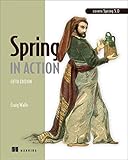Craig Walls
Author of 'Spring in Action' and 'Spring AI in Action'
Craig Walls is a Principal Engineer, Java Champion, Alexa Champion, and the author of Spring AI in Action, Spring in Action, and Build Talking Apps. He's a zealous promoter of the Spring Framework, speaking frequently at local user groups and conferences and writing about Spring. When he's not slinging code, Craig is planning his next trip to Disney World or Disneyland and spending as much time as he can with his wife, two daughters, 1 bird and 2 dogs.Presentations
Spring Boot: From zero to production in 90 minutes
9:00 AM MDT
In this example-driven presentation, we'll start with an empty directory and have an application (simple as it may be) running in a production environment, leveraging Spring and Spring Boot.
Spring Boot's primary purpose is to make Spring easier to work with. It achieves this in three ways:
Automatic configuration : Considering what's on the runtime classpath as well as other factors, Spring Boot can automatically configure components in a Spring application context.
Simplified dependency management : Taking advantage of transitive dependency resolution at build-time, Spring Boot offers several “starter” dependencies, focused on specific characteristics of an application, that transitively bring in libraries to enable development of those characteristics.
Runtime insight : Spring Boot offers insight into the inner workings of a running application via REST endpoints and/or JMX MBeans to better understand what makes a running application tick.
All together, Spring Boot lets you focus on fulfilling your application's requirements without worrying about writing code that satisfies the needs of a framework.
Reactive Spring: End-to-End
11:00 AM MDT
In this example-driven session, we'll build a complete (albeit simple) Spring application, leveraging Spring's support for reactive programming at all levels, from the database to the client.
Traditionally, applications have been built using a blocking, synchronous model. Although comfortable and intuitive for most programmers, this model doesn't scale well. And although there are several new approaches to reactive programming, they don't necessarily fit into the familiar programming model that Spring developers are accustomed to working with.
Spring 5 has introduced a set of new reactive features, enabling non-blocking, asynchronous code that scales well using minimal threads. Moreover, it builds on the same concepts and programming models that Spring developers have used for years.
Spring Boot: Application management with Actuator
1:00 PM MDT
In this session, we'll explore the Spring Boot Actuator, a runtime component of Spring Boot that lets you peer inside a running application and, in some cases, even tweak configuration on the fly. We'll look at many of the Actuator's endpoints, learn how to customize and even create new endpoints, and see how to expose Actuator metrics to several popular instrumentation and monitoring systems.
Spring Boot makes developing applications with Spring easy work by offering auto-configuration for many common application scenarios. And with Spring Boot's starter dependencies, even an application's build file can be easily managed. But Spring Boot's powers don't end when the application is deployed. That's where the real fun begins.
Extreme Spring Testing
3:00 PM MDT
In this session, we'll look at various ways that the latest features of Spring and Spring Boot can help with testing the tough-to-test portions of an application.
TBD
Books
Spring AI in Action
by Craig Walls
Generative AI tools like ChatGPT cause an immediate jaw drop for almost everyone who encounters them. Until recently, though, Java developers have had few good tools for adding AI features to existing and new applications. Spring AI, an exciting new extension for Spring and Spring Boot, changes the equation. Spring AI provides generative AI capabilities natively within the framework, so you can stick with Java end-to-end. Spring AI in Action shows you how!Spring in Action, 6th Edition
by Craig Walls
A new edition of the classic bestseller! Spring in Action, 6th Edition covers all of the new features of Spring 5.3 and Spring Boot 2.4 along with examples of reactive programming, Spring Security for REST Services, and bringing reactivity to your databases. You'll also find the latest Spring best practices, including Spring Boot for application setup and configuration.Build Talking Apps for Alexa
by Craig Walls
Voice recognition is here at last. Alexa and other voice assistants have now become widespread and mainstream. Is your app ready for voice interaction? Learn how to develop your own voice applications for Amazon Alexa. Start with techniques for building conversational user interfaces and dialog management. Integrate with existing applications and visual interfaces to complement voice-first applications. The future of human-computer interaction is voice, and we’ll help you get ready for it.Spring in Action, 5th Edition
by Craig Walls
Spring Framework has been making Java developers more productive and successful for over a dozen years, and it shows no signs of slowing down!
Spring in Action, 5th Edition is the fully-updated revision of Manning's bestselling Spring in Action. This new edition includes all Spring 5.0 updates, along with new examples on reactive programming, Spring WebFlux, and microservices. Readers will also find the latest Spring best practices, including Spring Boot for application setup and configuration.
Purchase of the print book includes a free eBook in PDF, Kindle, and ePub formats from Manning Publications.




